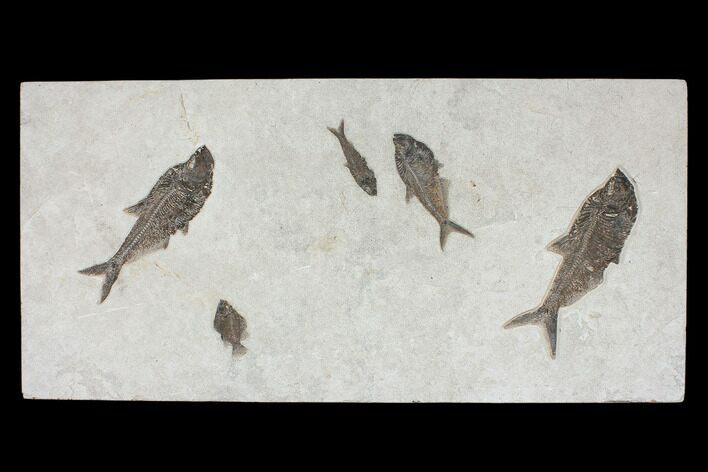This Specimen has been sold.
58" Wide Green River Fossil Fish "Mural" - Authentic Fossils
This is a spectacular fossil fish "mural" from the Green River Formation of Wyoming. It measures 58 x 28" and features three different types of fish fossils. The three largest fish on the plate are Diplomystus dentatus, the largest of which is 17.5" long. There is also a large Knightia eocaena and a Cockerellites liops.
The smaller Diplomystus, Knightia and Cockerellites have been inlaid into the slab which the two larger Diplos are in their natural position in the rock. Other than the inlaying the fish fossils have not been restored or painted. The large slab of rock has been backed with wood for stability is ready to be hung on a wall.
Because of the size of the plate it must be shipped on a pallet via freight. Freight shipping costs within the continental US are included in the price. Shipping outside of the continental US is extra and will be billed after purchase. Please contact us if you need a shipping quote.
Fossil fish from the 18 inch layer split out "ghosted" underneath the surface of the rock. Typically only bumps from the back bone can be seen in faint relief against the surface of the rock. Because of this they typically collect this layer at night using high powered lighting which allow them to better see the shadows from these bumps on the rock. These fish must then be prepared removing all of the matrix from on top of them, a very meticulous and time consuming process.
The smaller Diplomystus, Knightia and Cockerellites have been inlaid into the slab which the two larger Diplos are in their natural position in the rock. Other than the inlaying the fish fossils have not been restored or painted. The large slab of rock has been backed with wood for stability is ready to be hung on a wall.
Because of the size of the plate it must be shipped on a pallet via freight. Freight shipping costs within the continental US are included in the price. Shipping outside of the continental US is extra and will be billed after purchase. Please contact us if you need a shipping quote.
Fossil fish from the 18 inch layer split out "ghosted" underneath the surface of the rock. Typically only bumps from the back bone can be seen in faint relief against the surface of the rock. Because of this they typically collect this layer at night using high powered lighting which allow them to better see the shadows from these bumps on the rock. These fish must then be prepared removing all of the matrix from on top of them, a very meticulous and time consuming process.
SPECIES
Knightia eocaena, Diplomystus dentatus & Cockerellites liops
LOCATION
Kemmerer, Wyoming
FORMATION
Green River Formation
SIZE
58 x 28", Largest Fish 17.5", about 100 lbs
CATEGORY
SUB CATEGORY
ITEM
#104584
We guarantee the authenticity of all of our specimens.
 Reviews
Reviews















